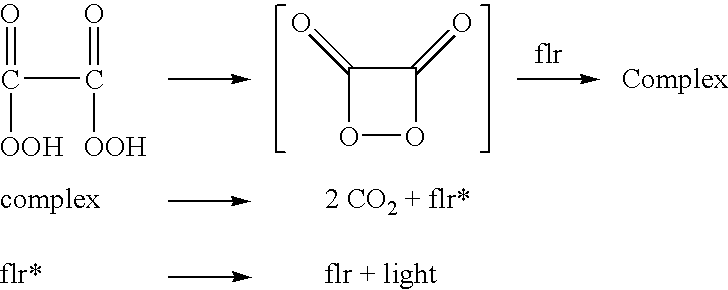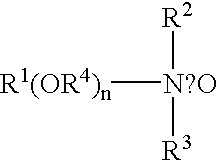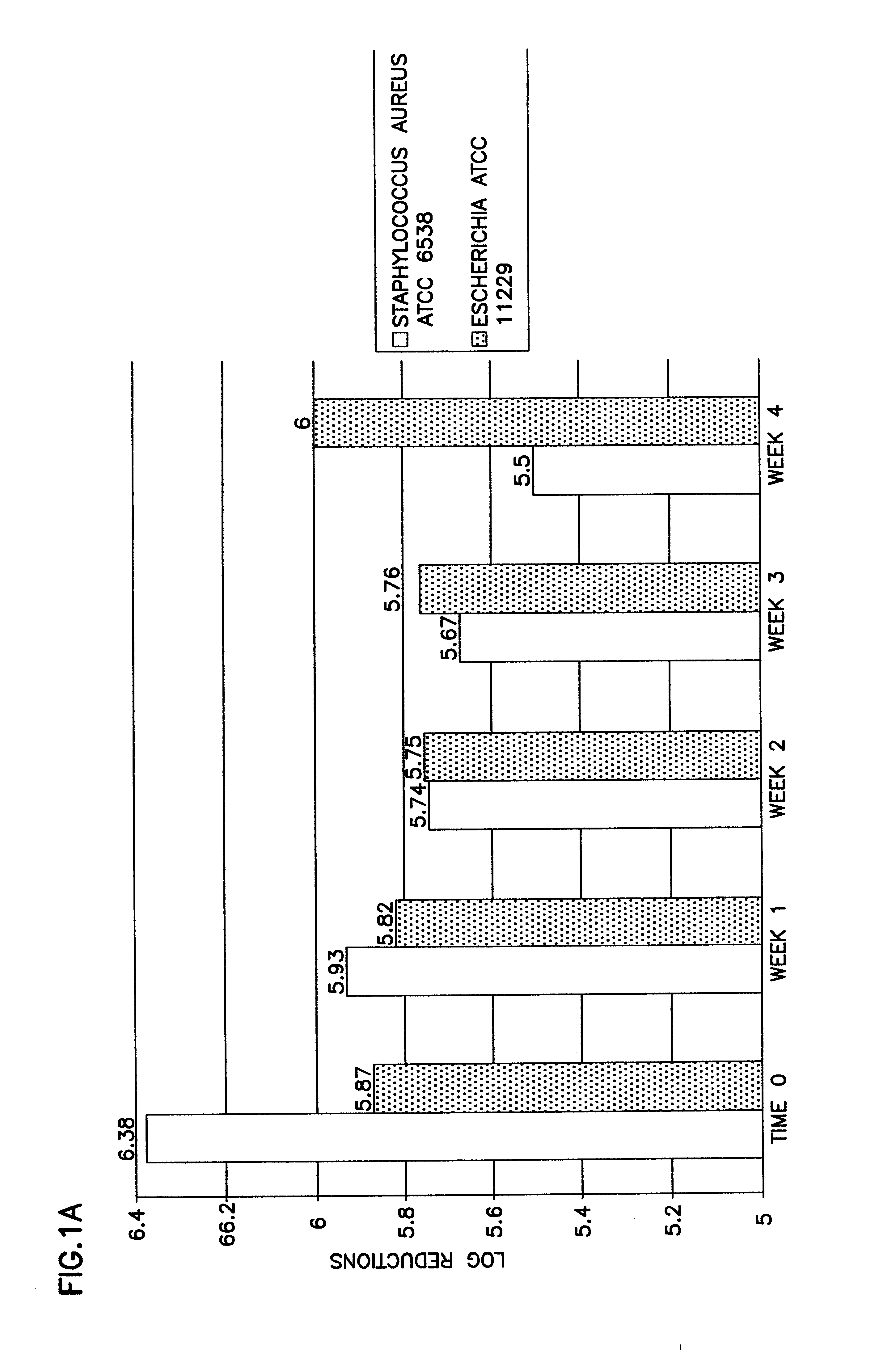Acidic aqueous chlorite teat dip with improved visual indicator stability, extended shelf life, sanitizing capacity and tissue protection
a technology of aqueous chlorite and teat dip, which is applied in the direction of diagnostic recording/measuring, detergent compounding agents, antibacterial agents, etc., can solve the problems of reducing milk yield, reducing quality, and most common and most costly diseases affecting dairy herds, so as to reduce wasteful and costly disposal, enhance safety, and reduce the effect of surface area
- Summary
- Abstract
- Description
- Claims
- Application Information
AI Technical Summary
Benefits of technology
Problems solved by technology
Method used
Image
Examples
example i
is a representative embodiment of this invention which illustrates a bovine mastitis treatment having barrier film properties. Antimicrobial effect is provided by generation of chlorine dioxide caused by disproportionation of chlorite ion upon admixture of composition base with activator and by the resident biocidal activity of protonated nonanoic acid.
A 16 liter batch of the following experimental base formula part and 1 kilogram of the ClO.sub.2.sup.-1 part was prepared by blending the ingredients as shown.
Base Formula (Part I) (pH=2.8)
Ingredients Wt % Grams Glycerin, 96% 5.00 800.05 Isopropanol, 99% 2.00 320.05 Nonanoic (Pelargonic) 1.50 240.05 Acid Lactic Acid, 88% 2.95 472.03 *Xanthan Gum 0.30 48.02 (KELTROL .RTM. K5C151) Deionized Water 60.76 9721.62 Potassium Benzoate 0.20 32.01 KOH, 45% 0.29 46.40 Octane Sulfonate 17.00 2720.02 **ELVANOL .RTM. Premix, 10% 10.00 1600.00 TOTAL 100.00 16000.25 *KELTROL .RTM. K5C151 is a grade of xanthan gum manufactured by Kelco. **ELVANOL .RTM...
example ii
Example II is a further example of this invention which differs from Example I in that the resident biocidal activity is contributed by dodecylbenzene sulfonic acid. The hydrotropic agent, octane sulfonate, is not required in this formula for physical stability.
A seven kilogram batch of the following base formula part and a one kilogram batch of the ClO.sub.2.sup.-1 activator part was prepared.
Base Formula (Part II) (pH=2.9)
Ingredients % Grams Glycerin, 96% 5.00 350.10 Dodecylbenzene Sulfonic 2.00 140.01 Acid, 97% Xanthan Gum 0.30 21.01 *KELTROL .RTM. K5C151 Deionized Water 78.14 5469.90 Lactic Acid, 88% 2.95 206.51 KOH, 45% 1.41 98.73 Potassium Benzoate 0.20 14.00 **ELVANOL .RTM. Premix, 10% 10.00 700.06 TOTAL 100.00 7000.32 *KELTROL .RTM. K5C151 is a grade of xanthan gum manufactured by Kelco. **ELVANOL .RTM.* Premix: 10% aqueous solution of ELVANOL .RTM. 90-50. ELVANOL .RTM. 90-50 is a grade of polyvinyl alcohol manufactured by E. I. duPont.
Activator ClO.sub.2.sup.-1 Formula (Par...
example iii
Example III is a representative composition of the invention illustrating a bovine mastitis treatment without a barrier film property and having no thickening nor film-forming agents. A surfactant, NEODOL.RTM. 25-9, is included for teat cleansing and surface wetting.
A two hundred gram batch of the following experimental base formula and a I kilogram batch of the ClO.sub.2.sup.-1 activator part was made.
Base Formula (Part I) (pH=2.7)
Ingredients Wt % Grams Glycerin, 96% 5.00 10.0 C.sub.12-15 alcohol (9 mole) 0.50 1.00 ethoxylate NEODOL* 25-9 Pelargonic Acid 0.50 1.00 Lactic Acid, 88% 2.95 5.90 Deionized Water 75.44 150.88 Octane Sulfonate 7.00 14.00 KOH, 45% 0.61 1.22 Dye-F, D & C 4.00 8.00 Green #3-1.0% aq. active *Pigment, 5.0% 4.00 8.00 TOTAL 100.00 200.00 *Pigment: PYLAKLOR .RTM. Yellow LX-10192 and Permanent Green S-722 (50:50 blend) manufactured by Pylam Products Co. Inc.
Activator ClO.sub.2.sup.-1 Formula (Part II) (pH=12.3)
Ingredients Wt % Grams Deionized Water 50.00 500.00 Sod...
PUM
| Property | Measurement | Unit |
|---|---|---|
| wt % | aaaaa | aaaaa |
| pH | aaaaa | aaaaa |
| Wt % | aaaaa | aaaaa |
Abstract
Description
Claims
Application Information
 Login to View More
Login to View More - R&D
- Intellectual Property
- Life Sciences
- Materials
- Tech Scout
- Unparalleled Data Quality
- Higher Quality Content
- 60% Fewer Hallucinations
Browse by: Latest US Patents, China's latest patents, Technical Efficacy Thesaurus, Application Domain, Technology Topic, Popular Technical Reports.
© 2025 PatSnap. All rights reserved.Legal|Privacy policy|Modern Slavery Act Transparency Statement|Sitemap|About US| Contact US: help@patsnap.com



